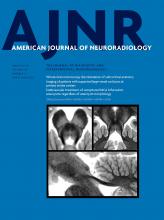We read with interest the recent article describing the engorgement of deep medullary veins (DMV) in patients with neurosarcoidosis (NS).1 The findings of DMV engorgement on susceptibility-weighted imaging have also intrigued us, and we recently published our experience in such cases.2 We agree with some of the findings reported in this article, such as occurrence of perivascular enhancement (PVE) in about half of these patients, increased occurrence of microhemorrhages, and a tendency toward worse neurologic outcomes. Even though the latter was not statistically significant, we suspect that it may, at least partially, be related to the small sample size.
Even though the authors mention that the DMV engorgement is not secondary to downstream venous occlusion, they agree that the pathophysiology of these findings remains unclear. This issue is further compounded by the absence of any correlation with neural tissue biopsy, conventional angiography studies, or any changes in DMV with time, especially with regard to immunosuppressive therapy, which limits any educated extrapolation or inference of the presented data.
We suspect that the engorged DMVs, as seen on SWI, reflect underlying venous phlebitis. This is based on the previously reported postmortem literature, which showed that the venous involvement was most common in the paraventricular region, and our own experience, in which we evaluated 4 patients with engorged DMVs.2,3 In all of our patients, we also had conventional angiography data as well as neural tissue biopsy. The venous phase of the angiographic studies confirmed the presence of tortuous and engorged veins, and the brain biopsy also found a predominant venous involvement.
Even though venous involvement in NS is fairly well-recognized in the postmortem literature, the under-recognition on imaging is likely due to lack of sequences such as SWI, which are more sensitive to tissue susceptibility. The introduction of SWI as a routine clinical sequence has more recently led to greater recognition of this imaging finding. In some ways, we wonder if SWI has provided the missing link that connects the postmortem literature and in vivo findings. Another reason for our suspicion is based on our anecdotal experience with patients with NS, in which mild cases of engorged DMVs do improve when patients receive immunosuppressive therapy and also appear worse when patients present with NS flare. In patients in whom they have been present for a while, such fluctuations, however, tend to be less frequent, possibly secondary to irreversible injury. The presence of PVE in a similar distribution also supports the possibility that there is a superimposed component of perivascular inflammation. We agree with the authors that this may be a combination of engorged vessels and perivascular involvement. In fact, we recently performed vessel wall imaging in 1 such case and noted that the cortical veins did show circumferential enhancement, corresponding to the SWI findings, a likely reflection of underlying vascular inflammation.4
An interesting question here, if SWI does indeed reflect venous involvement, is whether SWI findings can be used as a surrogate biomarker for ongoing vascular inflammation in NS cases. Even though this is open to further research, on the basis of our experience with limited patients, we suspect that vessel wall imaging and SWI are reflecting different components of venous involvement. One, therefore, may not be substituted for the other, especially because the SWI findings may become irreversible in chronic cases. Nevertheless, the possibility that SWI findings likely reflect underlying NS-associated phlebitis does add a new dimension to the NS imaging spectrum. Even though a lack of any neural tissue banks in NS would preclude retrospective evaluation of imaging and postmortem data and the overall uncommon nature of NS would limit a prospective single-center study, the significance of SWI findings may be better clarified through multicenter pooling of cases in which neural biopsy and conventional angiography data are available.
- © 2019 by American Journal of Neuroradiology












